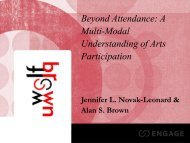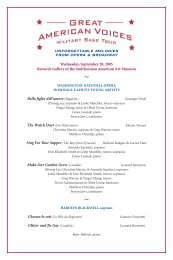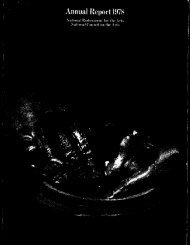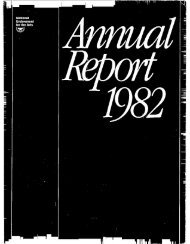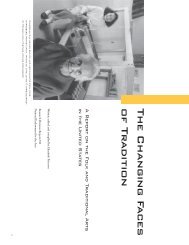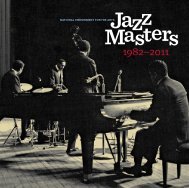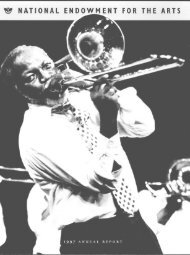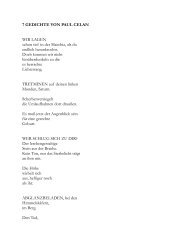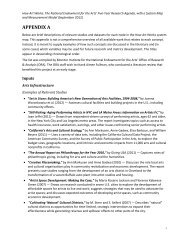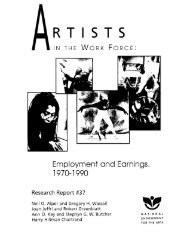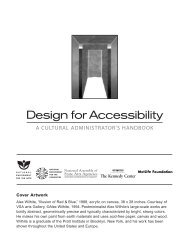You also want an ePaper? Increase the reach of your titles
YUMPU automatically turns print PDFs into web optimized ePapers that Google loves.
development and implementation of local cultural plans<br />
through community partnerships of arts and non-arts organizations.<br />
During its first year, <strong>the</strong> program increased <strong>the</strong> number<br />
of NEA direct grants in <strong>the</strong> targeted states by more than<br />
350 percent.<br />
The Folk & Traditional <strong>Arts</strong> Infrastructure Initiative, also begun in 1998, continued to serve <strong>the</strong><br />
folk and traditional arts nationwide by funding research, documentation and preservation, professional<br />
staff support, and broad dissemination of art <strong>for</strong>ms through instruction, per<strong>for</strong>mances<br />
and exhibitions. New in 1999 was a partnership project with <strong>the</strong> U.S. Department of Justice’s<br />
Office of Juvenile Justice and Delinquency Prevention that aims to prevent juvenile crime through<br />
participation in arts programs. The <strong>Endowment</strong> also helped Americans celebrate <strong>the</strong> arrival of <strong>the</strong><br />
new millennium by funding a wide range of <strong>National</strong> Millennium Projects, bringing new artistic<br />
works to new audiences and communities across <strong>the</strong> country.<br />
During 1999, <strong>the</strong> <strong>Endowment</strong> conducted a comprehensive assessment of its support <strong>for</strong> arts organizational<br />
development through Planning & Stabilization grants. The agency convened leaders<br />
from <strong>the</strong> cultural, educational, philanthropic, technological and business sectors in a series of nine<br />
colloquia held in Washington, D.C. that were open to <strong>the</strong> arts community. The series examined<br />
such issues as audience development, funding partnerships, in<strong>for</strong>mation technology, leadership<br />
development and capitalization strategies <strong>for</strong> arts organizations.<br />
The <strong>Endowment</strong> fur<strong>the</strong>r served <strong>the</strong> arts field and <strong>the</strong> public by expanding <strong>the</strong> resources available<br />
on its Web site. An example is Lessons Learned: A Planning Toolsite, an on-line collection of articles<br />
by arts professionals in <strong>the</strong> areas of audience building, capital campaigns, strategic planning,<br />
community partnerships and social enterprise.<br />
Six seats on <strong>the</strong> 20-member <strong>National</strong> Council on <strong>the</strong> <strong>Arts</strong> again were designated by law <strong>for</strong><br />
Congressional members serving in a non-voting, ex officio capacity. O<strong>the</strong>r Council members were<br />
private citizens appointed by <strong>the</strong> President and confirmed by <strong>the</strong> Senate. The Council continued<br />
to advise <strong>the</strong> Chairman on policies and programs; screen nominations from <strong>the</strong> public<br />
<strong>for</strong> <strong>the</strong> <strong>National</strong> Medal of <strong>Arts</strong>; and provide a second level of grant proposal review. Panels<br />
of experts, including arts professionals and knowledgeable laypersons, provided <strong>the</strong> initial<br />
review of all grant applications.<br />
This publication reflects <strong>the</strong> <strong>Endowment</strong>’s grantmaking structure that began in Fiscal Year<br />
1997 and remains in effect. It presents a representative sampling of <strong>the</strong> agency’s activities<br />
that took place between October 1, 1998 and September 30, 1999. The year’s<br />
financial transactions and a history of NEA appropriations are included at <strong>the</strong> end.<br />
Grant applications, publications, research reports, <strong>the</strong> NEA’s strategic plan and<br />
complete lists of Fiscal Year 1999 grants, cooperative agreements and interagency<br />
transfers are available on <strong>the</strong> <strong>Endowment</strong>’s Web site at www.arts.gov.<br />
These items may also be obtained by written request to <strong>the</strong> NEA Office of<br />
Communications, or by calling <strong>the</strong> <strong>National</strong> <strong>Endowment</strong> <strong>for</strong> <strong>the</strong> <strong>Arts</strong> at 202-682-5400.<br />
Points of Departure: Art on <strong>the</strong><br />
Line is a series of site-specific<br />
installations in historic train<br />
stations along Philadelphia’s<br />
Main Line developed by <strong>the</strong><br />
Main Line Art Center in<br />
Haver<strong>for</strong>d, Pennsylvania.<br />
Pictured here is Lounge 1999<br />
by artist Kay Rosen at <strong>the</strong><br />
Wynnewood Station. Photo by<br />
Gregory Benson<br />
Caroline Clay portrays<br />
a saxophone player searching<br />
<strong>for</strong> her sound in this scene<br />
from Oo-Bla-Dee per<strong>for</strong>med<br />
by <strong>the</strong> Goodman<br />
Theater/Chicago Theater<br />
Group in Chicago. Photo by<br />
Liz Lauren<br />
5



